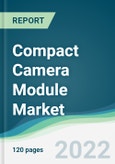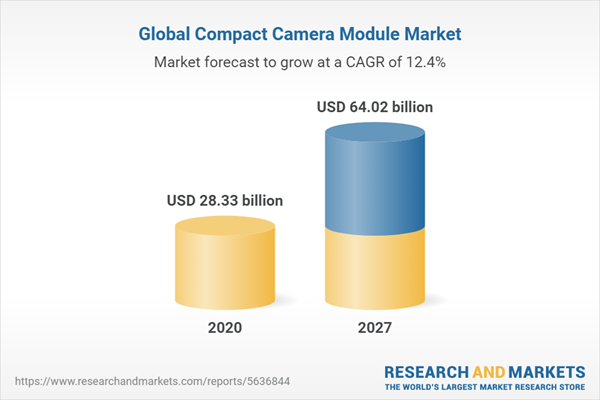Furthermore, the rapid advancements in sensor technology have increased the application of multiple compact camera modules. Manufacturers of smartphones and automobiles are integrating an increasing number of features. Rear-facing and front-facing cameras, as well as CIS, OIS, and lenses, are some examples. For instance, ams AG developed one of the world's smallest digital camera modules in December 2020. The company reported the pre-release of one of the smallest and lightest 100k pixel image sensors for usage in mobile or wearable handsets, such as virtual reality (VR) headsets. The new NanEyeC image sensor is available as a lensed chip-scale module with a 1mm2 footprint and a weight of around 1g. The NanEyeC camera is a full-featured image sensor that comes as a lensed surface-mount module measuring 1mm x 1mm. Similarly, in September 2021, Digital Media Professionals Inc. announced that it will begin accepting orders for a high-precision compact embedded monocular camera system in the first quarter of the fiscal year 2022.
Increased Application in the Automotive Industry
The market for compact camera modules is being driven by its increased application in automobiles for advanced driving assistance and automotive electronics. Automotive cameras have progressed from an optional feature to a must-have standard feature, and laws in the European Union and the United States are facilitating this movement. For instance, the EU Council of Ministers passed a general safety regulation in November 2019, requiring automakers to incorporate advanced safety features in all new automobiles sold in the EU. These advanced safety technologies include camera-based driver monitoring. Starting in 2022, all new type-approved automobiles with a certain level of autonomous driving capabilities will be subject to the new restrictions, which will be phased in over four years. By 2026, the regulation will apply to all new cars sold in the EU, regardless of their level of automation. Such regulations by governments around the world are expected to boost the global market for compact camera modules during the projected timeframe.
Increased technological advancements by key players will also aid in market growth. For instance, in June 2019, the Dual-cam two-lens camera was created by ZF, the world's top manufacturer of automotive cameras, exclusively for the commercial truck sector and to be used in conjunction with other ZF ADAS solutions. Similarly, in May 2019, The OVM7251 CameraCubeChip® module was launched by OMNIVISION Technologies, Inc., a leading producer of innovative digital imaging systems. The OVM7251 is a 640 x 480 VGA resolution camera module with a tiny form factor, low energy consumption, and low price. It is based on the 3-micron OmniPixel®3-GS global shutter technology.
In addition, the growing partnerships among major players are also anticipated to propel market growth. For instance, in July 2021, a North American electric vehicle firm awarded Samsung Electro-Mechanics a camera contract for a next-generation electric car. Samsung Electro-Mechanics was chosen as the ultimate provider in the competitive bidding process.
By application, the compact camera module market is segmented into consumer electronics, security and surveillance, communication devices, medical devices, and others.
Consumer electronics holds the largest market share of the compact camera module market due to the growing consumer specifications and competitive nature of the market. Rising penetration of consumer electronic devices such as smartphones, digital cameras, computers, laptops, etc. are expected to drive the demand for compact camera modules. The growth of the market is attributed to the increasing adoption of high-resolution cameras in smartphones for both back and front-facing mobile cameras. Rising demand for advanced computers, mobile phones and defence-related electronic devices is forcing manufacturers to develop new products with innovative technology that is expected to drive the demand for compact camera modules across the consumer electronics industry. Moreover, the continuous development in the sensor’s technology and the growing trend towards the depth effect of the mobile camera have increased the application of multiple compact camera modules for smartphones. The rapid increase in smartphone penetration and rising disposable income are driving the population for the quick switch to the latest technologies in consumer electronics. For instance, Xiaomi mobile, a Chinese smartphone giant is planning to launch the Xiaomi 12 Ultra which will feature a large rear camera module that spreads almost across the width of the smartphone.
COVID-19 scenario
The compact camera module market had been growing at a healthy pace before the outbreak of the COVID-19 pandemic. The increased use in the mobile and consumer electronics industries has been one of the major drivers of market growth. However, the COVID-19 pandemic led to the decline of the market size of compact camera modules in 2020 due to production & supply chain disruptions, and reduced demand from consumers. Thus, the projection for the compact camera module market in the COVID-19 scenario is significantly revised downwards.
The COVID-19 decreased the revenue generation opportunity for the compact camera module manufacturers by an estimated US$13.005 billion in 2020 in comparison to the no COVID-19 scenario. Many leading market leaders for compact camera modules such as Primax Electronics suffered revenue losses in 2020. For instance, the revenue of the non-PC segment of the company includes compact camera modules.
Market Segmentation:
BY APPLICATION
- Consumer Electronics
- Security and Surveillance
- Communication Devices
- Medical Devices
BY COMPONENTS
- Lens
- Actuators
- Sensors
- Adhesives
BY GEOGRAPHY
- North America
- USA
- Canada
- Mexico
- South America
- Brazil
- Argentina
- Europe
- Germany
- France
- United Kingdom
- Spain
- Middle East and Africa
- Saudi Arabia
- Israel
- Asia Pacific
- China
- India
- Japan
- South Korea
- Others
Table of Contents
Companies Mentioned
- Truly Opto- Electronics Ltd.
- Ams AG
- LG Innotek Co. Ltd
- Sunny Optical Technology (Group) Company Limited
- LITE-ON Technology Corporation
- Olloclip
- Chicony Electronics Co. Ltd
- Holitech Technology
- Cowell E Holdings Inc
- Henkel
Table Information
| Report Attribute | Details |
|---|---|
| No. of Pages | 120 |
| Published | June 2022 |
| Forecast Period | 2020 - 2027 |
| Estimated Market Value ( USD | $ 28.33 billion |
| Forecasted Market Value ( USD | $ 64.02 billion |
| Compound Annual Growth Rate | 12.3% |
| Regions Covered | Global |
| No. of Companies Mentioned | 10 |









